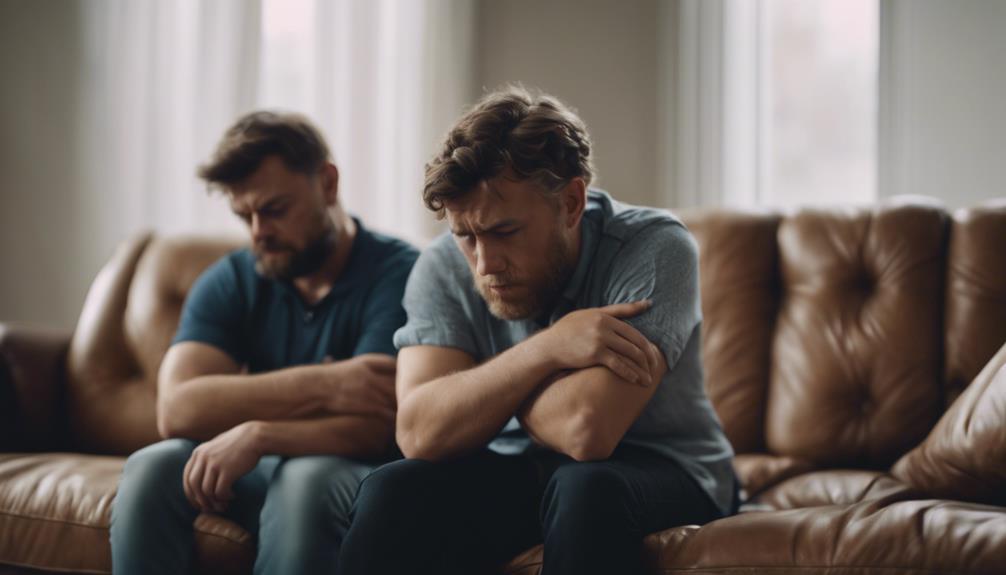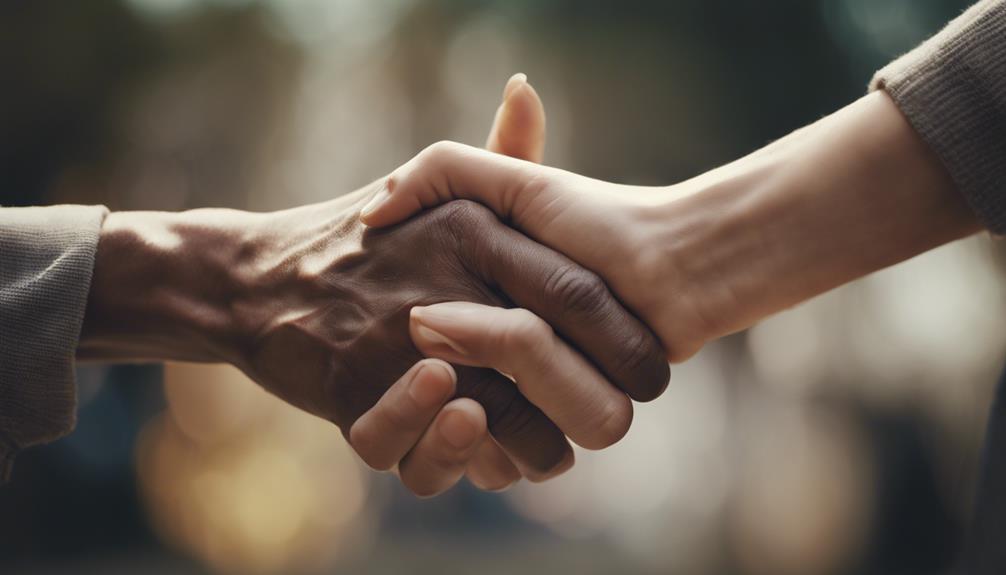Understanding learned helplessness in relationships is vital. It can lead to passivity, lack of motivation, and communication breakdown. This pattern can keep a relationship stagnant and imbalanced in power dynamics. To address it, recognize the signs like low self-esteem and giving up easily. Break the cycle by acknowledging maladaptive patterns, setting boundaries, and seeking support. Empower change together by prioritizing open communication and sharing responsibilities. This effort can help overcome feelings of powerlessness and hopelessness. By actively working on these aspects, you can foster healthier relationship dynamics. More insights await on this essential topic.
Key Takeaways
- Recognize maladaptive patterns and power imbalances.
- Address feelings of powerlessness and resignation.
- Encourage open communication and shared responsibilities.
- Seek support to break free from learned helplessness.
- Establish clear boundaries to promote equality in relationships.
Effects of Learned Helplessness in Relationships
Learned helplessness in relationships manifests as passivity, lack of motivation, and emotional disconnection, leading to detrimental effects on the dynamics between partners. When one partner becomes passive and lacks motivation to actively engage in the relationship, it can create a sense of imbalance and resentment. This passive behavior often results in a breakdown in communication, where important issues go unaddressed, further deepening the emotional disconnection between partners. Over time, this pattern can solidify into a stagnant relationship dynamic, where both partners feel stuck and unable to move forward.
The stagnant relationship dynamic perpetuated by learned helplessness can foster an imbalance of power, with one partner shouldering the majority of responsibilities while the other withdraws. This imbalance not only hinders the growth and health of the relationship but also breeds feelings of frustration and helplessness. Addressing learned helplessness involves recognizing these patterns, fostering open communication, sharing responsibilities, and establishing clear personal boundaries to promote a more balanced and fulfilling relationship dynamic.
Signs of Learned Helplessness in Adults

Exhibiting passivity in decision-making and problem-solving, adults experiencing learned helplessness often display a lack of motivation to change their circumstances or improve their situation. They may struggle with low self-esteem, feeling helpless in challenging situations, leading to a sense of resignation and acceptance of negative outcomes without attempting change.
Individuals with learned helplessness may give up easily, perceiving a lack of control over their lives. This negative mindset can also manifest as signs of depression, affecting mental health and overall well-being.
It's important to recognize these signs, especially in the context of abusive relationships where learned helplessness can be exacerbated. Seeking help through cognitive behavioral therapy can be a beneficial step to overcome learned helplessness.
Breaking the Cycle of Learned Helplessness

Recognizing maladaptive patterns in relationships is essential for breaking the cycle of learned helplessness. When we experience learned helplessness, it can feel like we're trapped in a state of powerlessness and unable to make positive changes. This often stems from traumatic events or being in an abusive relationship where our feelings of helplessness become ingrained. Red flags signaling the development of learned helplessness often include a lack of control over our circumstances and a sense of resignation to our situation.
To break learned helplessness, we must embrace change and actively work towards regaining our sense of agency. By acknowledging our state of learned helplessness and taking steps to address it, we can start to shift the dynamics in our relationships. Setting boundaries, seeking support from a counselor, and encouraging equal participation can all contribute to breaking this harmful cycle. Remember, breaking the cycle of learned helplessness is possible with determination and a commitment to personal growth.
Overcoming Learned Helplessness Together

To conquer learned helplessness in relationships, partners must prioritize open communication and equal participation. It's common for individuals in relationships to feel stuck or powerless when faced with challenges, but the good news is that overcoming learned helplessness is achievable when both partners work together.
When we look at the effects of learned helplessness, it's clear that it can negatively affect the dynamics of a relationship, leading to feelings of hopelessness. By recognizing these patterns and actively addressing them, partners can break free from this cycle.
Shared responsibilities and setting boundaries often play a vital role in empowering both individuals to take control of their situation. Seeking guidance from a relationship counselor can provide additional support and perspective in overcoming these difficulties.
Empowering Change in Relationships

Breaking the cycle of learned helplessness in relationships involves actively empowering each other through communication and setting clear boundaries. Recognizing patterns of learned helplessness is the first step towards fostering change. By acknowledging these behaviors and their impact, we can create opportunities for change and growth within the relationship.
Communication plays a vital role in this process, allowing us to express our needs, desires, and boundaries effectively. Setting and enforcing personal boundaries is essential for promoting empowerment and autonomy. Encouraging equal participation and shared responsibilities can shift power dynamics, fostering a more balanced and healthy relationship.
Seeking guidance from a relationship counselor can provide valuable tools and support for initiating positive change. Remember, change is possible, and by empowering each other and working together, we can break free from learned helplessness and cultivate a more fulfilling relationship.
Frequently Asked Questions
What Is Learned Helplessness in Relationships?
Learned helplessness in relationships is a belief of powerlessness that hinders efforts to improve the relationship. It can lead to passivity, causing one partner to lack motivation to make positive changes.
This mindset often results in resentment, breakdowns in communication, and emotional disconnection. Overcoming learned helplessness involves recognizing patterns, open communication, encouraging equal participation, and setting boundaries.
It's essential to address this issue to avoid stagnation or toxicity in relationships.
What Are the 3 Elements of Learned Helplessness?
The three elements of learned helplessness are a belief that outcomes are uncontrollable, a sense of powerlessness, and a tendency to give up easily in challenging situations.
These factors combine to create feelings of helplessness, leading to passivity and resignation in the face of adversity.
The belief that one can't control their circumstances, feelings of powerlessness, and giving up quickly contribute to the cycle of helplessness.
How Do I Stop Feeling Helpless in a Relationship?
To stop feeling helpless in a relationship, we must first acknowledge our emotions and communicate openly with our partner. Setting boundaries and encouraging equal participation can help regain a sense of control.
Seeking guidance from a relationship counselor is also beneficial. By actively addressing these issues together, we can break the cycle of helplessness and foster a healthier dynamic built on mutual respect and understanding.
What Is the Learned Helplessness Theory of Attachment?
The learned helplessness theory of attachment posits that repeated negative relationship experiences can lead to a belief in powerlessness to change circumstances. This belief can shape attachment styles, impacting how individuals navigate current and future relationships. Those with learned helplessness may struggle to assert needs or set boundaries.
Understanding this theory sheds light on how past rejection or neglect influences adult attachment patterns, offering insights into interpersonal dynamics.
Conclusion
As we navigate the complexities of relationships, it's important to recognize the impact of learned helplessness. By understanding the signs and effects of this phenomenon, we can work towards breaking the cycle and empowering change together.
Just as a seed must break through the soil to grow, we too can overcome obstacles and flourish in our relationships.
With patience, communication, and a willingness to learn and grow, we can cultivate healthy and fulfilling connections with our loved ones.










